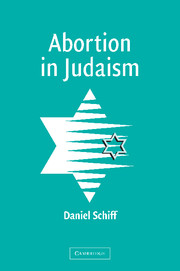Book contents
- Frontmatter
- Contents
- Preface
- 1 The conundrum takes shape: foundational verses
- 2 Evaluating life: rabbinic perspectives on fetal standing
- 3 Divining a prohibition: the positions of the Rishonim and Acharonim
- 4 No clear consensus: the sages of a rising modernity
- 5 The struggle returns: Jewish views begin to take form
- 6 Confronting a new reality: legislation for a Jewish state
- 7 A halakhic challenge: discerning Jewish abortion principles
- Glossary
- Bibliography
- Index
2 - Evaluating life: rabbinic perspectives on fetal standing
Published online by Cambridge University Press: 09 November 2009
- Frontmatter
- Contents
- Preface
- 1 The conundrum takes shape: foundational verses
- 2 Evaluating life: rabbinic perspectives on fetal standing
- 3 Divining a prohibition: the positions of the Rishonim and Acharonim
- 4 No clear consensus: the sages of a rising modernity
- 5 The struggle returns: Jewish views begin to take form
- 6 Confronting a new reality: legislation for a Jewish state
- 7 A halakhic challenge: discerning Jewish abortion principles
- Glossary
- Bibliography
- Index
Summary
The rabbinic framework pertaining to fetal existence was already largely shaped by the time the Mishnah and midrashic texts came to be recorded in the second and third centuries of the Common Era. In many ways, it was a structure which served to enlarge and extend the plain meaning of the Exodus text. The Tannảim, inheritors of the Eretz Yisrael approach, simply continued the legal tradition that regarded the killing of the fetus as a tort rather than a homicide. They did so, not just in circumstances such as those depicted in Exodus 21:22–23, but in every context that a Jew might encounter.
The Mishnah pointedly declares that – among a range of other legal conditions that begin only at birth – one who kills a one-day-old baby, presumed to be full-term, is criminally liable and deserves the death penalty; the fetus, however, is not included within this provision. It is true that there was a Tannảitic view that regarded all fetuses as being in a state of “doubtful viability.” Unless it could be established that a full nine-month pregnancy had been completed, this condition continued until the baby came to be regarded as a bar kayamah, a viable being, at thirty days after birth. The “doubtful viability” designation must have buttressed the argument against feticide being deemed homicide. Nevertheless, the “doubtful viability” doctrine carried with it the risk of the law blurring the distinction between the unborn and the born.
- Type
- Chapter
- Information
- Abortion in Judaism , pp. 27 - 57Publisher: Cambridge University PressPrint publication year: 2002



